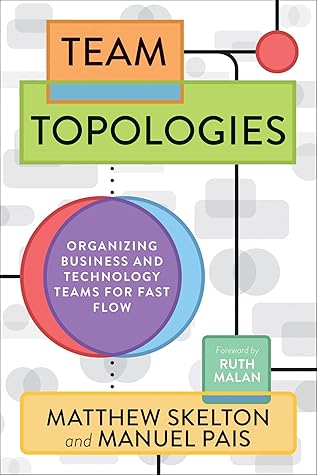More on this book
Community
Kindle Notes & Highlights
Read between
March 3 - March 13, 2022
The X-as-a-Service team interaction mode is suited to situations where there is a need for one or more teams to use a code library, component, API, or platform that “just works” without much effort, where a component or aspect of the system can be effectively provided “as a service” by a distinct team or group of teams.
The facilitating team interaction mode is suited to situations where one or more teams would benefit from the active help of another team facilitating (or coaching) some aspect of their work. The facilitating interaction mode is the main operating mode of an enabling team (see Chapter 5) and provides support and capabilities to many other teams, helping to enhance the productivity and effectiveness of these teams.
How to train for collaboration mode. Some training or coaching in basic collaboration skills such as pair programming, mob programming, and whiteboard sketching—together with specific training around boundary-spanning collaboration—can be valuable for teams interacting using collaboration mode.
How to train for X-as-a-Service mode. Some training or coaching in core user-experience (UX) and developer-experience (DevEx) practices can be valuable for teams interacting using X-as-a-Service mode.
How to train for facilitating mode. Some training or coaching in how to facilitate or how to be helped by another team can be valuable for teams interacting using facilitating mode.
The architect should be thinking: “Which team interaction modes are appropriate for these two teams? What kind of communication do we need between these two parts of the system, between these two teams?” The architect in an organization following the Team Topologies approach is therefore the designer of team APIs that anticipate the intended software architecture.
Use Awkwardness in Team Interactions to Sense Missing Capabilities and Misplaced Boundaries The patterns of team interactions can be used to detect and respond to problems with the design of the system, potentially anticipating software problems before the code reaches production.
when designing modern organizations for building and running software systems, the most important thing is not the shape of the organization itself but the decision rules and heuristics used to adapt and change the organization as new challenges arise;
Historically, many organizations have treated “develop” and “operate” as two distinct phases of software delivery, with very little interaction and certainly almost no feedback from operate to develop. Modern software delivery must take a completely different approach: the operation of the software should act as and provide valuable signals to the development activities. By treating operations as rich, sensory input to development, a cybernetic feedback system is set up that enables the organization to self steer.
environmental situation, and what they do makes no sense. When speed of change was measured in months or years (as in the past), organizations could manage with very slow and limited environmental sensing; however, in today’s network-connected world, high-fidelity sensing is crucial for organizational survival, just as an animal or other organism needs senses to survive in a competitive, dynamic natural environment.
As Sriram Narayan says, “Project sponsors looking to reduce cost opt for a different team of lower-cost people for maintenance work. This is false economy. It hurts the larger business outcome and reduces IT agility.”8
Increasingly, software is less of a “product for” and more of an “ongoing conversation with” users. To make this ongoing conversation effective and successful, organizations need a “continuity of care” for its software.
The reason so many organizations experience so many problems with software delivery is because most organizations have an unhelpful model of what software development is really about. An obsession with “feature delivery” ignores the human-related and team-related dynamics inherent in modern software, leading to a lack of engagement from staff, especially when the cognitive load is exceeded.


